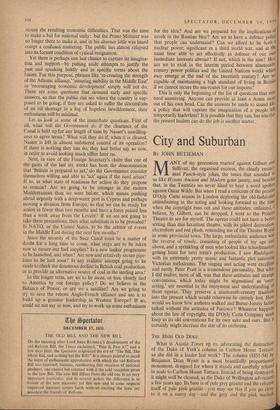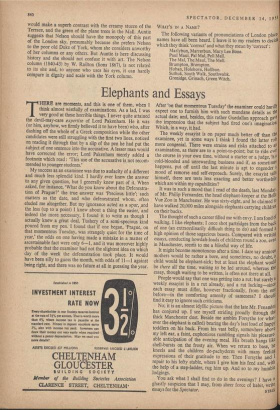City and Suburban
BY JOHN BETJEMAN MANY of my generation reacted against Gilbert and Sullivan, the organised encores, the clearly enunei' ated Punch-style jokes, the tunes that sounded to us like Hymns Ancient and Modern gone jaunty, and besides that, in the Twenties we never liked to hear a word spoken against Oscar Wilde. But when I read a criticism of the present D'Oyly Carte season in London deploring the old-fashioned attitudinising in the acting and looking forward to the time when the copyright runs out and these attitudes, ordained, l believe, by Gilbert, can be dropped, I went to the Princes Theatre to see for myself. The operas could not have a better setting than this luxuriant theatre, with its gilded decoration, electroliers and red plush, reminding me of the Theatre Royal in some provincial town. The large, enthusiastic audience was, the reverse of rowdy, consisting of people of my age and above. and a sprinkling of men who looked like schoolmasters getting hints for next term's production. I saw Ruddigare' with its extremely pretty music and fantastic plot satirising Victorian melodrama. The singing and acting were excellent and surely Peter Pratt is a tremendous personality. But what 1 did realise, most of all, was that these attitudes and strange conventions, which today might be stigmatised as 'over; acting,' are essential to the enjoyment and understanding 01 these operas. They preserve a nineteenth-century tradition into the present which would otherwise be entirely lost. How would we know how wsthetes walked and Burne-Jonesy ladies talked without the attitudes of Patience? Whatever happens about the law of copyright, the D'Oyly Carte Company must keep to its old conventions for its own sake and ours. But it certainly might increase the size of its orchestra.
THE Won OLD DUKE What is Auntie Times up to, advocating the destruction of the Duke of York's column in Carlton House Terrace. as she did in a leader last week? The column (1831-34) by Benjamin Dean Wyatt is a most beautifully proportioned monument, designed for where it stands and carefully related in scale to Carlton House Terrace. Instead of being destroyed. it might well be cleaned, as the Duke of Wellington advocated a few years ago. Its base is of pale grey granite and the column itself of pale pink granite—you may see this if you go, close to it on a sunny day—and the grey and the pink washed would make a superb contrast with the creamy stucco of the Terrace, and the green of the plane trees in the Mall. Auntie suggests that Nelson should have the monopoly of this part of the London sky, presumably because she prefers Nelson to the poor old Duke of York, whom she considers unworthy of her columns or any others. But Auntie is here discussing history and she should not confuse it with art. The Nelson column (1840-43) by W. Railton (lions 1867), is not related to its site and, to anyone who uses his eyes, it can hardly compare in dignity and scale with the York column. The following variants of pronunciations of London place' names have all been heard. I leave it to my readers to decide which they think 'correct' and what they mean by 'correct':
Marlybun, Marrerbun, Mary Lee Bone.
Paul Maul, Pal Mal, Pell Me11.
The Mal, The Maul, The Me11.
Brumpton, Brompton.
Hoban, Holeborn, Hollbun.
Suthuk, South Walk, Southwahk.
Grenidge, Grinach, Green Witch.











































 Previous page
Previous page